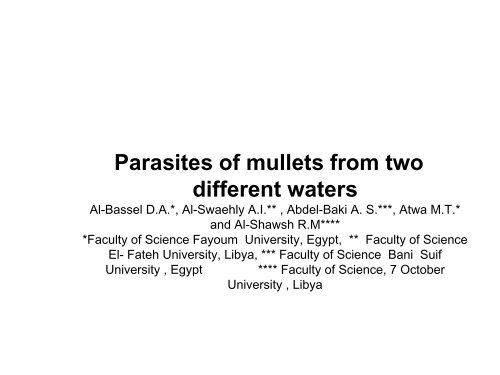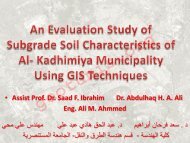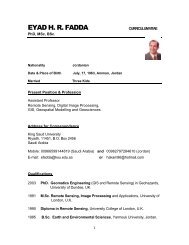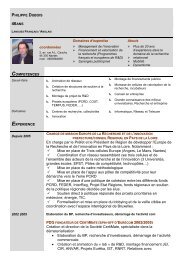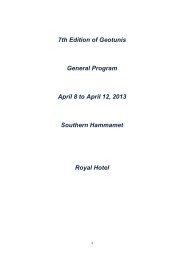Parasites of mullets from two different waters
Parasites of mullets from two different waters
Parasites of mullets from two different waters
You also want an ePaper? Increase the reach of your titles
YUMPU automatically turns print PDFs into web optimized ePapers that Google loves.
<strong>Parasites</strong> <strong>of</strong> <strong>mullets</strong> <strong>from</strong> <strong>two</strong><br />
<strong>different</strong> <strong>waters</strong><br />
Al-Bassel D.A.*, Al-Swaehly A.I.** , Abdel-Baki A. S.***, Atwa M.T.*<br />
and Al-Shawsh R.M****<br />
*Faculty <strong>of</strong> Science Fayoum University, Egypt, ** Faculty <strong>of</strong> Science<br />
El- Fateh University, Libya, *** Faculty <strong>of</strong> Science Bani Suif<br />
University , Egypt **** Faculty <strong>of</strong> Science, 7 October<br />
University , Libya
ABSTRACTS<br />
Two <strong>different</strong> localities were selected for the present<br />
investigation. Out <strong>of</strong> 200 Mugil cephalus, 63 (31.5%)<br />
were found infected . Out <strong>of</strong> 119 Mugil cephalus, 44 (36.9<br />
%) collected <strong>from</strong> Lake Qarun at Fayoum in Egypt were<br />
found infected with Trematoda , Acanthocephala ,<br />
Trichodina and Myxosporea .The incidence <strong>of</strong> infection<br />
88.6 % , 27. 2% , 95.5% and 27.3% respectively .<br />
<strong>Parasites</strong> <strong>of</strong> the Egyptian <strong>mullets</strong> includes: 4 species <strong>of</strong><br />
trematoda (Haplosplanchnus caudatus, H. pachysomus,<br />
Lecithobotrys putrescens and Dicrogaster contractus); one<br />
species <strong>of</strong> Acanthocephala (Neoechinorhynchus sp. );<br />
three species <strong>of</strong> Trichodina ( Trichodina lepsii ,T. puytoraci<br />
and T. batala ) and one species <strong>of</strong> Myxosporedia<br />
(Myxobolus. sp. ).
ABSTRACTS continue<br />
It is worth mentioned that protozoan infections were<br />
restricted in Egyptian <strong>mullets</strong> . On the other hand, out <strong>of</strong><br />
81 Mugil cephalus , 19 ( 23.45%) caught <strong>from</strong> the coastal<br />
water <strong>of</strong> the Mediterranean near Missurata in Libya were<br />
found infected with <strong>two</strong> genera <strong>of</strong> trematodes.<br />
(Vitellibaculum girelia and Lecithocladium exisum ). All<br />
parasites were figured and identified to the species level<br />
according to yamaguti,1971.
INTRODUCTION<br />
Two <strong>different</strong> saline <strong>waters</strong>, lake Qarun in Egypt and<br />
coastal water <strong>of</strong> the Mediterranean near Missurata in<br />
Libya were selected for the present study. Lake Qarun is<br />
the third largest lake in Egypt and the second most<br />
famous one after Lake Nasser in the southern part <strong>of</strong><br />
Egypt. It lies some 44 meters below sea level and<br />
occupies the lowest, northern section <strong>of</strong> the Fayoum<br />
depression. The Lake Qarun has a surface area <strong>of</strong> 214<br />
square kilometers. It has a maximum depth <strong>of</strong> just over 8<br />
meters and a volume <strong>of</strong> 800 million cubic meters. It is 42<br />
km long and 9 km wide at its broadest point (Meshal,<br />
1973).
INTRODUCTION continue<br />
The Mediterranean is a semi- enclosed Sea and almost<br />
suffering <strong>from</strong> several pollutants. In polluted Sea water,<br />
oxygen depletion, stress-induced mucus which support<br />
parasitic infestation on fishes, compounding an already<br />
stressful state .Fish parasites are nowadays considered<br />
as one <strong>of</strong> the most inviting fields <strong>of</strong> national research<br />
especially after the importance <strong>of</strong> fishes as a valuable<br />
source <strong>of</strong> protein, in which heavy infection may cause<br />
functional disturbances, retard growth, increase the<br />
susceptibility <strong>of</strong> fish for other infection and give the fish<br />
an unaesthetic appearance.
INTRODUCTION continue<br />
During the last decade, parasites <strong>of</strong> marine<br />
and fresh water fishes in Egypt have been<br />
received much attention (Al-Bassel,1997a,<br />
1997b,1999a,1999b,2000a,2000b,2001a,2<br />
001b,2002a,2002b,2003a,2003b,2004,200<br />
6a,2006b,2006c; Al-Bassel and El-<br />
Damarany,2001, Al-Bassel and<br />
Ohida,2006 and Al-Bassel et al., 2007) .
INTRODUCTION continue<br />
The <strong>mullets</strong> Mugil cephalus (Mugilidae) is considered a<br />
commercial marine fish .This species is omnivorous,<br />
feeds on plankton , thus it is more exposed to infection by<br />
trematodes than other marine fish, and is therefore<br />
selected for the present investigation. Libya was selected<br />
as the area since Mugil cephalus is a common species<br />
throughout most <strong>of</strong> the year. Although some information<br />
on the parasites <strong>of</strong> marine fishes <strong>from</strong> other areas is<br />
known, differences in the parasite fauna <strong>of</strong> a widely<br />
distributed species can be expected with <strong>different</strong><br />
geographical locations .The objective <strong>of</strong> this investigation<br />
was to study the natural parasite fauna <strong>of</strong> the <strong>mullets</strong> <strong>from</strong><br />
one region <strong>of</strong> its distribution and to extend our knowledge<br />
about the prevalence and distribution <strong>of</strong> parasites in Mugil<br />
cephalus in the Mediterranean Sea in Libya. In Egypt,<br />
research has been done on <strong>mullets</strong> and its parasites.
MATERIALS AND METHODS<br />
Smears <strong>from</strong> the skin, gill and fin surfaces are made on glass slides, air<br />
dried and fixed. Then, the whole body surface <strong>from</strong> just behind the<br />
gill cover till the end <strong>of</strong> the caudal fin was scraped using a scalpel<br />
blade or spatula. The scraped materials were then put on a glass<br />
slide, covered with a coverslip to be examined microscopically. In<br />
order to study the adhesive disc, positive smears were air-dried,<br />
then impregnated with Ag No3 and irradiated with UV (Klein's<br />
method).For studying the recorded Myxosporea, length and width <strong>of</strong><br />
cysts were measured then squashed for studying the spore<br />
morphology. Glycerin/gelatin mixture was used to preserve and<br />
examine some details <strong>of</strong> the spores. Measurements <strong>of</strong> the fresh<br />
spores were taken using calibrated ocular micrometer on Zeiss<br />
photomicroscope.
MATERIALS AND METHODS continue<br />
Organs are opened by a pair <strong>of</strong> fine scissors and<br />
left in 0.7% saline solution. A hand lens and a<br />
binocular dissecting microscope were used for<br />
the helminthological examination. The collected<br />
worms were cleaned by washing them several<br />
times with isotonic saline<br />
solution.Relaxation,fixation,staining and<br />
mounting were carried out by the usual way All<br />
measuments are in millimeter unless otherwise<br />
state.
The fish host <strong>of</strong> the present work<br />
Mugil cephalus was<br />
caught <strong>from</strong> <strong>two</strong><br />
<strong>different</strong> <strong>waters</strong> (Lake<br />
Qarun in Fayoum,<br />
Egypt and coastal<br />
water in Missurata,<br />
Libya) and<br />
investigation for<br />
parasites
RESULTS AND DISCUSSION
A) Protozoan<br />
infections
1-Trichodina lepsii Lom, 1962 (Fig. 1)<br />
S.bar = 10 µm<br />
Host: Mugil cephalus<br />
Location: gills<br />
Locality: Lake Qarun<br />
,Egypt<br />
This species was previously<br />
redescribed in details by<br />
Al-Bassel et al., 2007.<br />
This finding suggests that<br />
M. cephalus is the type<br />
host <strong>of</strong> this trichodinid<br />
and not Mugil auratus as<br />
proposed by Lom (1962).<br />
(Al-Bassel et al., 2007)
2-Trichodina puytoraci Lom, 1962 (Fig. 2)<br />
S.bar = 10 µm<br />
Host: Mugil cephalus<br />
Location: gills<br />
Locality: Lake Qarun ,<br />
Egypt<br />
This species was previously<br />
redescribed in details by<br />
Al-Bassel et al., 2007.<br />
This finding suggests that<br />
M. cephalus is the type<br />
host <strong>of</strong> this trichodinid<br />
and not Mugil auratus as<br />
proposed by Lom (1962).<br />
(Al-Bassel et al., 2007)
3-Trichodina batala Ali, 1996 (Fig. 3)<br />
S.bar = 10 µm<br />
Host: Mugil cephalus<br />
Location: gills<br />
Locality: Lake Qarun ,Egypt<br />
This species was previously<br />
redescribed in details by Al-<br />
Bassel et al., 2007. This<br />
finding suggests that M.<br />
cephalus is the type host <strong>of</strong><br />
this trichodinid. (Al-Bassel et<br />
al., 2007).<br />
The above three species were<br />
reported in the present work<br />
agreed fully with the<br />
description <strong>of</strong> Al-Bassel et al.,<br />
2007.
4 -Myxobolus sp. (Fig. 4 )<br />
(S.bar= 10 µm)<br />
Host: Mugil cephalus<br />
Location: body cavity and mesentery<br />
Locality: Lake Qarun ,Egypt<br />
Description:<br />
Only one Mugil cephalus was<br />
infected with one plasmodium <strong>of</strong><br />
this myxosporean.The cyst was<br />
embedded in the mesenteries <strong>of</strong><br />
the body cavity. Spores are oval to<br />
subspherical in frontal view. The<br />
polar capsules are pyriform,<br />
almost equal. Sporoplasm is<br />
binucleate and fills the all<br />
extracapsular space.
4 -Myxobolus sp.<br />
Discussion:<br />
Review <strong>of</strong> myxosporean infecting the <strong>mullets</strong><br />
indicated that 17 Myxobolus species is<br />
infecting this group <strong>of</strong> fishes. Only five<br />
Myxobolus species were found close in<br />
general shape to the present parasite.<br />
However, we refrain <strong>from</strong> final allocation <strong>of</strong><br />
this parasite till further examination <strong>of</strong><br />
mature spores.
B) Trematode<br />
infections
5-Haplosplanchnus Caudatus (Srivastava, 1939) (Fig. 5 )<br />
(S .bar =0.4 mm)<br />
Host: Mugil cephalus<br />
Location: Intestine<br />
Locality: Lake Qarun ,Fayoum,Egypt<br />
Description :<br />
The body is Y-Shaped, with unequal arms, one end<br />
is the oral sucker, the second end is the<br />
protruded ventral sucker and the third end<br />
formed <strong>of</strong> the curved posterior end <strong>of</strong> the body<br />
which looks like a tail like structure. The oral<br />
sucker is oval, subterminal. The ventral sucker<br />
is large club shaped found usually projected<br />
<strong>from</strong> the body but in some cases may be<br />
retracted into the body parenchyma. The<br />
pharynx is well developed, spherical in shape.<br />
The esophagus and the single simple straight<br />
intestinal caeca extend posteriorly to a short<br />
distance behind the level <strong>of</strong> the ventral sucker.<br />
The single testis is oval in shape lying at the<br />
posterid third <strong>of</strong> the body. genital pore opens<br />
between the oral and the ventral sucker.<br />
The ovary is oval in shape and lies at the right<br />
side, just anterior to testis. The vitelline follicles<br />
are few in number located in 3-4 groups in the<br />
lateral field surrounding the ovary. The uterus<br />
extends <strong>from</strong> the anterior margin <strong>of</strong> the testes<br />
up to the level <strong>of</strong> the ventral sucker and it is full<br />
<strong>of</strong> mature, large and yellow colored eggs.
Discussion<br />
H. caudatus recorded in the present work was<br />
closely similar in all its morphological aspects<br />
mentioned by Al-Bassel (1987) except that the<br />
eggs in the present study were slightly larger in<br />
size. Specimens identified by Ezz El-Dien (1990)<br />
<strong>from</strong> Mugil species caught <strong>from</strong> Red Sea and<br />
Raef (1990) <strong>from</strong> Mugil species obtained <strong>from</strong><br />
Mediterranean Sea were collectively larger in all<br />
measurements.
RESULTS<br />
6-Haplosplanchuns pachysomus (Eysenhardt,1829) Looss,1902<br />
( Fig. 6)<br />
Host: Mugil cephalus<br />
Location: Intestine<br />
Locality: Lake Qarun,Fayoum,Egypt<br />
Description:<br />
The worms are orange in color when fresh. They are fleshy parasites, fairly large.<br />
The oral sucker is triangular, muscular and subterminal .The ventral sucker is long,<br />
club – shaped, may be retracted into body parenchyma or projects prominently. The<br />
prepharynx is very short. The pharynx is well developed. The esophagus cannot be<br />
distinguished <strong>from</strong> the intestinal caecum which is a simple straight structure<br />
extending nearly to the middle <strong>of</strong> the body.<br />
The testis is single, globular in shape.<br />
The genital atrium is tubular .The genital pore lies between the oral and ventral<br />
sucker, and opens on a prominent papilla found between the <strong>two</strong> suckers. The ovary<br />
is spherical in shape and lies anterior to the testis. The vitelline follicles lies laterally<br />
near the ovary. The uterus is full <strong>of</strong> large and elongate eggs, which containing<br />
developing miracidia. The excretory vesicle is present and ends by a terminal<br />
execratory pore.
6-Haplosplanchuns pachysomus (Eysenhardt,1829) Looss,1902<br />
(S .bar 0.4 mm)<br />
Host: Mugil cephalus<br />
Location: Intestine<br />
Locality: Lake Qarun,Fayoum,Egypt<br />
Description:<br />
The worms are orange in color when fresh.<br />
They are fleshy parasites, fairly large. The<br />
oral sucker is triangular, muscular and<br />
subterminal .The ventral sucker is long, club<br />
– shaped, may be retracted into body<br />
parenchyma or projects prominently. The<br />
prepharynx is very short. The pharynx is well<br />
developed. The esophagus cannot be<br />
distinguished <strong>from</strong> the intestinal caecum<br />
which is a simple straight structure extending<br />
nearly to the middle <strong>of</strong> the body.<br />
The testis is single, globular in shape.<br />
The genital atrium is tubular .The genital pore<br />
lies between the oral and ventral sucker, and<br />
opens on a prominent papilla found between<br />
the <strong>two</strong> suckers. The ovary is spherical in<br />
shape and lies anterior to the testis. The<br />
vitelline follicles lies laterally near the ovary.<br />
The uterus is full <strong>of</strong> large and elongate eggs,<br />
which containing developing miracidia. The<br />
excretory vesicle is present and ends by a<br />
terminal execratory pore.
Discussion<br />
H. pachysomus was described <strong>from</strong> Mugil cephalus and<br />
M. cheloat by Looss, 1902.In Egypt, H. pachysomus was<br />
first described <strong>from</strong> Mugil cephalus and M ramada by<br />
Fischthal and Kuntz (1963). Then, it was redescribed<br />
<strong>from</strong> M. cephalus, Liza ramada, M. chelo and M. saliens<br />
<strong>from</strong> Lake Qarun by Al-Bassel (1987). Also, Al-Bassel<br />
(1990) described the same parasite in M. cephalus and<br />
L. ramada <strong>from</strong> Lake Edku.<br />
The present material is similar to that described by<br />
Fishthal and Kuntz (1963), Al-Bassel (1987) and Eid<br />
(1997) in their main characteristics, but there are certain<br />
minor differences in body length and measurements <strong>of</strong><br />
some internal organs.
RESULTS<br />
7-Dicrogaster contractus (Looss, 1902) (Fig. 7 )<br />
Host: Mugil cephalus<br />
Lacation: Intestine<br />
Locality: Lake Qarun<br />
Description:<br />
It is an oval worm. The body is mostly covered with spines. The oral sucker is sub<br />
teeminal, oval in shape. A well developed muscular pharynx is present; it is globular<br />
in shape. The esophagus is long. The intestinal caeca is saccular in shape extends to<br />
the middle <strong>of</strong> the worm .The ventral sucker is oval in shape<br />
The testis is globular in shape, located at the middle <strong>of</strong> he posterior half <strong>of</strong> the body. The<br />
cirrus pouch is well developed, pre-acetabular in position. The cirrus pouch contains<br />
prostatic gland cells, a hermaphroditic duct and internal seminal vesicle, the external<br />
seminal vesicle is oval in shape. The ovary is nearly spherical, smaller than testes<br />
and postacetabular in position .The vitelline glands are in 2 groups mostly at one<br />
lateral side between the testis and the caecal end. The excretory vesicle is spherical<br />
in shape and opens at the posterior end with a terminal excretory pore. The eggs are<br />
oval in shape
7-Dicrogaster contractus (Looss, 1902) (Fig. 7 )<br />
(S .bar 0.2 mm)<br />
Host: Mugil cephalus<br />
Lacation: Intestine<br />
Locality: Lake Qarun<br />
Description:<br />
It is an oval worm. The body is mostly covered<br />
with spines. The oral sucker is sub teeminal,<br />
oval in shape. A well developed muscular<br />
pharynx is present; it is globular in shape.<br />
The esophagus is long. The intestinal caeca<br />
is saccular in shape extends to the middle <strong>of</strong><br />
the worm .The ventral sucker is oval in<br />
shape<br />
The testis is globular in shape, located at the<br />
middle <strong>of</strong> he posterior half <strong>of</strong> the body. The<br />
cirrus pouch is well developed, preacetabular<br />
in position. The cirrus pouch<br />
contains prostatic gland cells, a<br />
hermaphroditic duct and internal seminal<br />
vesicle, the external seminal vesicle is oval<br />
in shape. The ovary is nearly spherical,<br />
smaller than testes and postacetabular in<br />
position .The vitelline glands are in 2 groups<br />
mostly at one lateral side between the testis<br />
and the caecal end. The excretory vesicle is<br />
spherical in shape and opens at the<br />
posterior end with a terminal excretory pore.<br />
The eggs are oval in shape
Discussion<br />
In the present work, D. contractus was identical in its morphological aspects<br />
to Looss (1902) specimens except for minor differences in certain<br />
measurements. In the redescription recorded by Fares and Maillard (1974),<br />
the excretory vesicle was y-shaped while in the present material it was<br />
spherical, a feature which has been recorded by Looss (1902). Al-Bassel<br />
(1987) recorded the parasite but his measurements were smaller (total body<br />
length 0.49-0.65) than that recorded in the present work (0.738-0.838)<br />
hence, other body organs were also smaller than that obtained in the<br />
present work, including prepharynx and intestinal caeca. It was important to<br />
noticed that the genus Dicrogaster has been originally reported <strong>from</strong> fishes<br />
in the Mediterranean sea (Looss, 1902), this genus has apparently reached<br />
Fayoum area with Mugil spp. Which have been transferred to water bodies<br />
in Fayoum (Khalil, 1978).Al-Bassel (1987) recorded the parasite <strong>from</strong> Lake<br />
Wadi Al-Rayan in Fayoum Province and not <strong>from</strong> Lake Qarun, although<br />
specimens <strong>of</strong>. D. contractus collected <strong>from</strong> Mugil cephalus in the present<br />
work, collected <strong>from</strong> Lake Qarun.
RESULTS
8-Lecithobotrys putrescens Looss, 1902 ( Fig. 8)<br />
( S. bar 0.3 mm<br />
Host:<br />
Mugil cephalus<br />
Location: intestine<br />
Locality: Lake Qarun ,Egypt<br />
Description:<br />
The worms are grayish white in color, elongated<br />
and tapering anteriorly. The whole body<br />
surface <strong>of</strong> the worm is covered by spines<br />
which are easily shed. The oral sucker is subterminal<br />
and relatively larger than the ventral<br />
sucker. The pharynx is large, elongated in<br />
shape. The prepharynx is short . The<br />
intestinal caeca are tubular in shape and<br />
extending back far beyond the ventral sucker<br />
to the posterior end <strong>of</strong> testis. The bifurcation<br />
<strong>of</strong> the intestine occurs dorsal to the ventral<br />
sucker.<br />
The testis is located not far behind the ventral<br />
sucker and it is nearly rounded . The cirrus<br />
pouch is egg-shaped. The ovary is median,<br />
spherical in shape, lying behind the testis.<br />
The vitelline glands are formed <strong>of</strong> <strong>two</strong><br />
irregular shaped follicles in each laterally.<br />
The eggs are numerous .The excretory<br />
vesicle is large and saccular opened by the<br />
main excretory pore which is sub-terminal<br />
and lies in a large depression in the posterior<br />
extremity <strong>of</strong> the worm.
Discussion<br />
The morphological characters <strong>of</strong> L.<br />
putrescence under investigation were<br />
agreed with that described by Al-Bassel<br />
(1987) although the measurements <strong>of</strong> the<br />
ovary and testis in the present specimens<br />
were smaller in size, a feature which may<br />
be due to incompletely grown parasite<br />
obtained in the present work.
9- Vitellibaculum girelia Montgomery , 1957 (Fig. 9)<br />
(S .bar 0.5 mm)<br />
Host : Mugil cephalus<br />
Location : intestine<br />
Locality : Missurata , Libya<br />
Description:<br />
The entire worm oval. The oral sucker is<br />
terminal . Prepharynx is long. A well<br />
developed muscular pharynx is present; it is<br />
globular in shape. The esophagus absent .<br />
The intestinal caeca is tubular in shape .The<br />
ventral sucker is larger than the oral suker.<br />
The testes are tandom , located at the middle <strong>of</strong><br />
he posterior half <strong>of</strong> the body. The cirrus<br />
pouch is well developed, pre-acetabular in<br />
position. The ovary is nearly spherical,<br />
smaller than testes and anterior to the<br />
testes. The vitelline glands are scattered in<br />
posterior half <strong>of</strong> the body. The excretory<br />
vesicle is y- shaped and opens at the<br />
posterior end with a terminal excretory pore.<br />
The eggs are oval in shape<br />
9
Discussion<br />
This species was originally described by<br />
Montgomery ,1957 <strong>from</strong> Girelia uigricans<br />
fish <strong>from</strong> California . The present work<br />
agreed fully with the original description<br />
,but the present description represent new<br />
host and new locality recored
RESULTS AND DISCUSSION<br />
Host : Mugil cephalus<br />
Location : intestine<br />
Locality : Missurata , Libya<br />
Description:<br />
The entire worm elongate with tail like structure. The oral sucker is funelshaped.<br />
Pharynx is well developed. The esophagus is short . The intestinal<br />
caeca is tubular in shape .<br />
The testes are small , located at the middle <strong>of</strong> the body .The ovary is nearly<br />
spherical, larger than testes and posterior to testes. The vitelline glands<br />
tubular and consists <strong>of</strong> 7 covoluted posterior to ovary. The excretory vesicle<br />
is elongate, tubular in shaped and opens at the posterior end with a<br />
terminal excretory pore. The eggs are small.<br />
Discussion : •<br />
This species was originally described by (Rud, 1819) Luhe, 1901 <strong>from</strong><br />
Scombrus scombrus fish <strong>from</strong> the Mediterranian . The present work agreed<br />
fully with the original description ,but the present description represent new<br />
host and new locality recored.
10- Lecithocladium excisum (Rud , 1819) Luhe , 1901(Fig. 10 )<br />
(S .bar 0.3 mm)<br />
10<br />
Host : Mugil cephalus<br />
Location : intestine<br />
Locality : Missurata , Libya<br />
Description:<br />
The entire worm elongate with tail<br />
like structure. The oral sucker is<br />
funel-shaped. Pharynx is well<br />
developed. The esophagus is<br />
short . The intestinal caeca is<br />
tubular in shape .<br />
The testes are small , located at the<br />
middle <strong>of</strong> the body .The ovary is<br />
nearly spherical, larger than testes<br />
and posterior to testes. The<br />
vitelline glands tubular and<br />
consists <strong>of</strong> 7 covoluted posterior to<br />
ovary. The excretory vesicle is<br />
elongate, tubular in shaped and<br />
opens at the posterior end with a<br />
terminal excretory pore. The eggs<br />
are small.
Discussion :<br />
This species was originally described by (Rud, 1819)<br />
Luhe, 1901 <strong>from</strong> Scombrus scombrus fish <strong>from</strong> the<br />
Mediterranian . The present work agreed fully with<br />
the original description ,but the present description<br />
represent new host and new locality recored.
C) Acanthocephala<br />
infections
11- Neoechinorhynchus sp. (Figs. 11,12 ,13 )<br />
(S .bar 5 mm)<br />
11<br />
Host: Mugil cephalus<br />
Location: Intestine<br />
Locality: Lake Qarun, Egypt .<br />
Description:<br />
The body <strong>of</strong> the worm is elongated and<br />
cylindrical with truncate ends . The<br />
body is covered with a thin tegument.<br />
The proboscis is small and globular.<br />
The proboscis has 18 hooks arranged<br />
in three spiral rows, each row has six<br />
hooks, each hook is provided with root<br />
processes .The hooks <strong>of</strong> the first row<br />
are the largest. The proboscis is<br />
keeping in the proboscis receptacle<br />
when be invaginated. Three or four<br />
giant nuclei are present in the dorsal<br />
side while four are present on the<br />
ventral side. The <strong>two</strong> lemnisci are<br />
unequal. There is a few number <strong>of</strong><br />
ovarian balls represented the ovary .<br />
The uterine ball is oval ,followed by a<br />
short uterus opens into vagina and<br />
finally opens posteriorly by the female<br />
gono-pore.
Neoechinorhynchus sp. continue<br />
13 (S. bar 0.5mm ) 12( S.bar 0.4mm)<br />
13
Discussion<br />
The worm described above is evidently belonging<br />
to the genus Neoechinorhychus Hamann,<br />
1892.The <strong>two</strong> related species are the<br />
Neoechinorhynchus ichthyobori Saoud et aI.,<br />
1974 which was described <strong>from</strong> fresh water fish<br />
Ichthyoborus besse caught <strong>from</strong> the white Nile at<br />
Jebel Al-Awliya in Sudan and also<br />
Neoechinorhynchus sp, which was redescribed<br />
by Al-Bassel 1990 <strong>from</strong> Mugil cephalus caught<br />
<strong>from</strong> lake Edku. It is worth to mention that the<br />
present material was reported in a new locality.
Thank you


